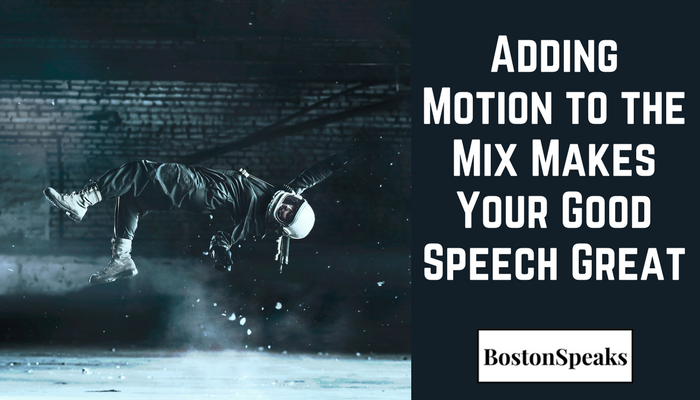Welcome back to my series on how to become a great public speaker! In part 1, I shared how important it is to choose a topic that you are passionate about. Choosing a topic that inspires you makes it so much easier for you to inspire your audience with your words.
This week I’m going to tell you how to share that enthusiasm and inspire your audience with nonverbal cues. Public speaking by definition is an exercise in verbal expression. You are there to say something and be heard. But being a great speaker is not just about the words.

I’m sure you’ve heard this saying before: “It’s not just what you say, but how you say it.”
Nonverbal Cues Tell Their Own Story
Have you ever noticed someone nodding their head as they listen to a speaker? It’s pretty easy to interpret that they agree with what the speaker is saying.
Skilled salespeople know it’s time to close the deal when their customer is leaning forward and listening intently, right? But if that customer is turned away with arms crossed — then, the salesperson better not bank on earning that commission.
We all communicate nonverbally. In fact, some studies indicate that up to 75% of all our communication is nonverbal. Our facial expression, body posture, eyes, and even our tone of voice send messages.
You are constantly sending signals with your body language, whether you realize it or not.
Great public speakers learn to control their nonverbal cues and use them to help convey their message.
How Do Gestures and Body Posture Help Communicate Your Message?
In his book, The Importance of Effective Communication, Professor Edward G. Wertheim names five ways that nonverbal cues can add to your spoken message. These methods apply whether you are speaking to a small group or up on a stage.
First, Wertheim wrote that our gestures can be used to reinforce or repeat a point being made verbally. For instance, as you are naming items on a list, you might use your fingers to count out each one.
Next, he noted that your actions may sometimes contradict your words. I mentioned this concept in my Tedx talk about listening. You will send a mixed signal if you appear to be speaking to someone and listening to what they have to say, but your feet are turned away from them.
Another example is the person who says, “Yes, that’s true,” while their head shake signals, “No.” (You can watch for that next time you ask someone if they like your cooking.)
Sometimes a gesture can substitute for a verbal message. The celebratory high five or “talk to the hand” motion are examples of this.
When you are speaking, you might want to just spread your hands in front of you with a gesture that says “See, the truth is right in front of us.”
We wave our hands in a crossing motion to say “No, no, no!” We use a shushing motion to ask people to keep a secret. These gestures are particularly effective when you want to draw your audience’s attention back to you.
When you fall silent, people have to look at your gestures to determine what you are trying to say.
Finally, gestures can be used to complement or accentuate a spoken message. When used this way, your body posture or motions accompany your words.
For instance, you might greet your audience by telling them how thrilled you are to be speaking to them and accompany that greeting with a little spring in your step or an open-armed gesture. To accentuate an important point, you might use the classic hand-in-palm fist slam.
Prepare and Practice Your Chosen Moves
If you are new to public speaking, it may seem awkward to pre-plan your gestures. But remember, whether you plan it or not, your body is conveying a message.
It is better for you and your audience if you think about and practice your moves in advance, so your message remains clear.
Besides, a little movement will get your blood flowing while you’re up on stage. So, move away from the podium grip or fig leaf stance and loosen up a little bit. You’ll have more fun and your audience will, too.
Want to try out some of your new moves on an audience? Join one of our BostonSpeaks classes. You can learn something new and practice what you know.
I love to share my passion for great communication. If you have any questions, don’t hesitate to ask! Learn even more about body language, public speaking and communication at the BostonSpeaks Blog.

Kit Pang is a Communication Expert, TEDx Speaker Coach, TEDx, Inbound and Keynote speaker, the host of the BostonSpeaksSeries and the founder of BostonSpeaks. He is on a mission to help individuals become exceptional speakers and communicators. Kit’s seminars and talks have been credited as super fun, engaging, soul-searching and insightful. www.bostonspeaks.com @kitpangx
Originally published at medium.com


